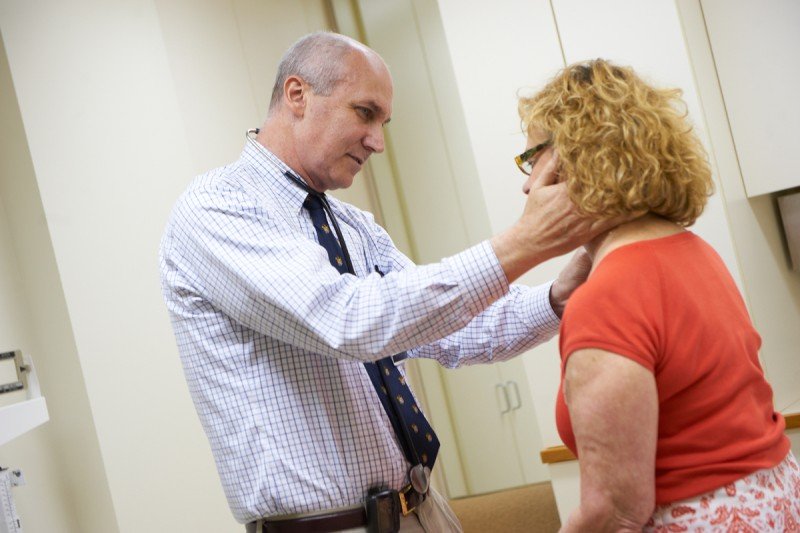
David Pfister, Chief of the Head and Neck Oncology Service, conducts examination of neck of patient.
Learn about active surveillance for thyroid cancer from our experts
When it comes to thyroid cancer, routine screening may do more harm than good for many people. The US Preventive Services Task Force (USPSTF) has issued a report, published in the Journal of the American Medical Association, recommending against screening for the disease in adults without any signs or symptoms.
Memorial Sloan Kettering surgical oncologist Luc Morris applauds the recommendation in an editorial published in JAMA Otolaryngology — Head & Neck Surgery.
“As physicians guided by the principle of ‘first, do no harm,’ we should be relieved that the USPSTF reached this conclusion,” he writes with co-author Louise Davies of the VA Outcomes Group.
MSK already takes a conservative approach toward thyroid cancer, allowing many patients to avoid unnecessary treatment by closely monitoring tumor growth. Dr. Morris explains how screening can lead to overdiagnosis of the disease and why, in many cases, active surveillance is often the best approach.
What is the significance of the USPSTF recommendation?
The USPSTF gave thyroid cancer screening a grade of D, meaning that there is a good chance it provides no net benefit or that the harms outweigh the benefits. The goal is to advise doctors not to routinely look for thyroid cancer in people without any symptoms by feeling for lumps on the neck, doing ultrasound imaging, or using other techniques. This sends a clear signal about something that may seem counterintuitive to many doctors and patients, who may assume that more information is always better.
Isn’t it good to screen for cancer so it can be caught early?
As we write in our editorial, screening tests can take healthy people who have no symptoms and turn them into “sick people” who have to undergo biopsies and then possibly surgery or other treatments. Screening for a cancer is helpful only if the test can effectively detect tumors that would go on to cause disease or death and are more treatable if found earlier.
In just the last 20 years, the number of thyroid cancer cases has increased dramatically. This is due to better methods of detection that can pick up very small nodules [lumps]. But we know that small papillary thyroid cancers, the most common type, typically do not grow or grow very slowly and never pose a threat. The more lethal types of thyroid cancer, such as anaplastic thyroid cancer, grow and spread very quickly and cause symptoms that lead to detection anyway. It is nearly impossible to identify these deadly cancers early with screening, since they tend to develop between screening episodes.
So overall, screening is likely to identify harmless cancers and miss those that actually could benefit from early treatment. We hope the USPSTF recommendation will discourage clinicians from screening and change the practice for the better.
If a thyroid nodule is detected, what is the best approach to determining whether it’s cancerous?
As we age, most of us will eventually develop thyroid nodules that can be identified on ultrasound examinations. Most small nodules do not need to be biopsied. Over the past few years, the American Thyroid Association [ATA] guidelines have helped physicians select which ones to biopsy and thus prevent overtreatment.
And if a thyroid nodule is found to be cancerous, what then?
There has been a growing acceptance in the medical community that low-risk thyroid cancers can be safely watched, and that less extensive treatment often produces the best outcomes. In 2015, the ATA issued treatment guidelines that stated, for the first time, that monitoring an early-stage papillary thyroid tumor instead of removing it is a reasonable option.
For several years at MSK, we have taken a tactic of active surveillance. This method was pioneered successfully here for men with low-risk prostate cancer, another slow-growing disease that historically has been overtreated. When someone comes in with a small papillary thyroid cancer that appears to be confined to the thyroid gland, our team of experts now tries to determine whether the patient is a good candidate for observation with ultrasounds at regular intervals.
Screening Not Recommended for Thyroid Cancer
For thyroid cancers that do require treatment, we have been at the forefront of selecting the more conservative surgery, lobectomy. [The procedure is also called hemithyroidectomy.] The ATA guidelines are also supportive of this concept for some thyroid cancers.
To better determine which tumors may be dangerous, [MSK endocrinologist] Michael Tuttle, [MSK physician-scientist] James Fagin, and [MSK genomics researcher] Michael Berger are actively trying to determine whether there is a genetic signature that would allow us to predict what’s going to happen. If we can identify which mutations are important, we could just use a small needle to biopsy the cancer. Then we could analyze the genes and be able to more accurately understand the likelihood that an individual tumor will need treatment.




